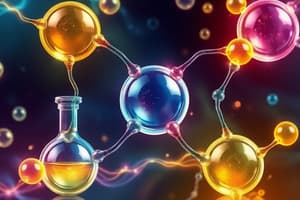Podcast
Questions and Answers
Which of the following best describes a Lewis acid?
Which of the following best describes a Lewis acid?
- A chemical species that readily donates its lone pair of electrons
- A chemical species that forms a dative bond with a Lewis base
- A chemical species with an empty orbital capable of accepting an electron pair from a Lewis base (correct)
- A chemical species with a filled orbital capable of donating an electron pair to a Lewis base
Which of the following is an example of a Lewis base?
Which of the following is an example of a Lewis base?
- CH4
- NH3 (correct)
- HCl
- H2O
In the context of a specific chemical reaction between NH3 and Me3B, what is formed?
In the context of a specific chemical reaction between NH3 and Me3B, what is formed?
- Me3B NH3
- Me3NH3
- NH3Me3
- NH3 BMe3 (correct)
What type of bond is formed in a Lewis adduct?
What type of bond is formed in a Lewis adduct?
How are the terms nucleophile and electrophile related to Lewis acids and bases?
How are the terms nucleophile and electrophile related to Lewis acids and bases?
Flashcards are hidden until you start studying
Study Notes
Lewis Acids and Bases
- A Lewis acid is a species that accepts a pair of electrons to form a covalent bond.
- A Lewis base is a species that donates a pair of electrons to form a covalent bond.
Formation of Lewis Adducts
- In the reaction between NH3 and Me3B, a Lewis adduct is formed.
- A Lewis adduct is a compound that results from the formation of a covalent bond between a Lewis acid and a Lewis base.
Bonding in Lewis Adducts
- The bond formed in a Lewis adduct is a covalent bond, resulting from the sharing of a pair of electrons between the Lewis acid and Lewis base.
Nucleophiles and Electrophiles
- A Lewis base can also be referred to as a nucleophile, as it donates a pair of electrons to form a covalent bond.
- A Lewis acid can also be referred to as an electrophile, as it accepts a pair of electrons to form a covalent bond.
- The terms nucleophile and electrophile are related to Lewis acids and bases, as they describe the electron-donating and electron-accepting properties of these species.
Studying That Suits You
Use AI to generate personalized quizzes and flashcards to suit your learning preferences.



